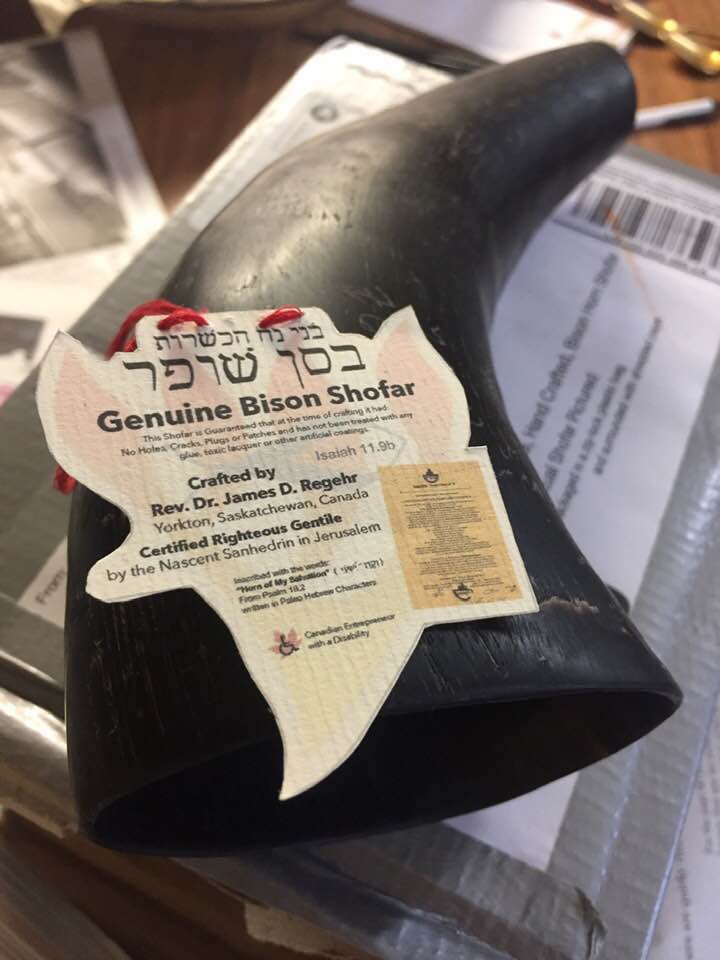Buffalo Horn Shofar - and a universal spiritual guide to sounding it
Just received this in the mail today, beautifully crafted by Dr James Regehr, a Noahide pastor in the prairie province - where the buffalo roam - of Saskatchewan: a buffalo-horn shofar! Designed and made for non-Jews, though with a lovely inscription in proto-Hebrew lettering; the alphabet that Moses used to write the Torah. Jews can’t employ ox or buffalo horn in a shofar (due to our unfortunate experiment with a certain golden calf) to fulfill the ritual mitzvah of shofar, of blowing the shofar to mark and celebrate the New Year. But we, and Noahides, can blow it - just to blow a shofar made from bison!
This one makes a nice deep sound. It sounds kind of like a fog-horn, but richer and, we would say, better.
Dr. Regehr's guide to shofar-blowing, below, is, like the shofar, very rich. It's a very spiritual document and it taught us, moved us, and impressed us.

Dr. Regehr's Guide to Sounding a Shofar
1) When sounding a shofar, one uses the buzzing of her/his lips along with breath. No voice is used to sound the shofar - only the breath. And since the Hebrew word for breath [ru'ach] is the same as the the word for wind and also “spirit” - when a person sounds the shofar, it is the “spirit” of the person that is sounding the shofar - making it, we would say, a pure expression to God; an expression absent of words - an expression absent of thought or deception or any form of rational thought or language.
It is a pure and simple expression: an expression of the soul in its purest and simplest form …
2) When sounding the shofar, one blows it to be heard over distances far greater than possible by the human voice alone. The sound of the shofar is, then, a sound both for the ears of other people as well as the “ears of all Creation” as well as the “ears of God Himself.” And the “message” of the sound of the shofar, being the purest expression of the soul is the cry of the soul that calls all people to repentance AND the cry of the soul along with all creation; longing for the redemption and restoration that will come when the Kingdom of God is established on the earth under the rule of the Messiah (that is, the lion lying down with the lamb, etc.).
It is also a cry of the soul to God Himself - both in worship and submission and penitence and longing for Him, and for eternity in His presence
3. When sounding the shofar, one unites her or his breath and spirit with and through the “spirit” of the animal whose horn has been crafted into that shofar. Thus, on a spiritual level, one is uniting mystically in an intercessory manner on behalf of the redemption and respiration of all the land and animals and plant life represented by the physical, geographical region where the animal whose horn is being sounded is indigenous
For example, to sound a traditional Israel ram’s horn shofar becomes an intercession for the land of Israel - the land where the ram was indigenous. The sounding of a Khudu Antelope shofar becomes an intercession on behalf of Ethiopia, where they are indigenous … and thereby for all of the continent of Africa … and then the sounding of a shofar from a North American bison thereby also has an intercessory dynamic on behalf of North America …
And then also the implication is that the call of repentance that the sounding of the shofar sends as it is being sounded, is most effectively received by the soul or spirit of the person hearing it when the shofar being used is crafted from the horn of an animal indigenous to that person’s home … in other words, that the ram’s horn is most deeply “heard” by the spirit of Jewish people; the Khudu shofar is most deeply “heard” by the spirit of a person from Africa; the bison shofar is most deeply heard by the spirit of a person from North America … and so on ….
by Dr. James D. Regehr

